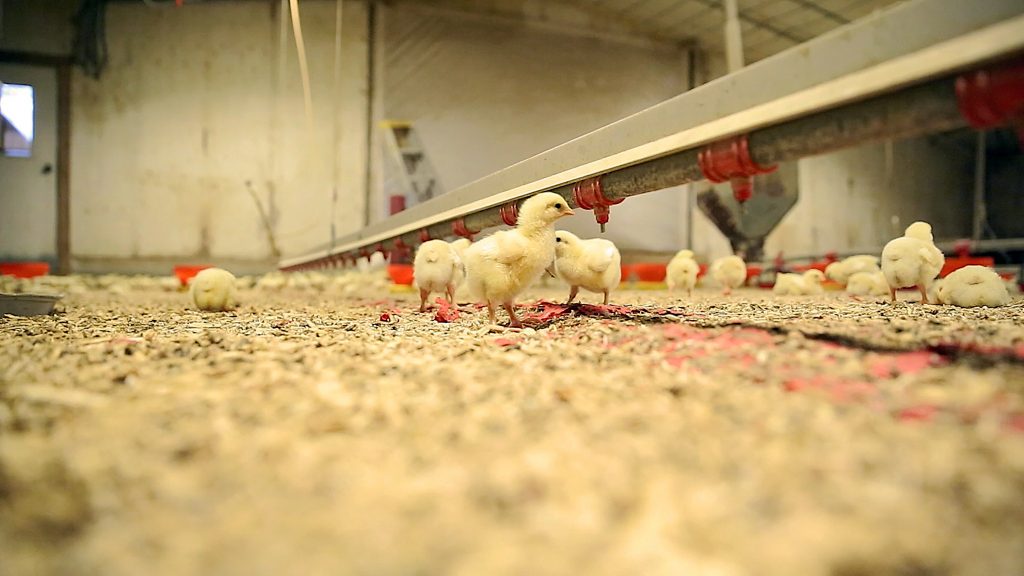
Tyson Foods rolls out high-tech, high-touch animal welfare program
By Tyson Foods
Features Equipment New Technology Poultry Equipment Production Animal Welfare Company News Livestock Production Poultry Production Production Protection United States Baby chicks raised by an independent farmer for Tyson Foods. The company has launched a new initiative to improve the care of chickens on the farm and at its processing plants. Tyson
Baby chicks raised by an independent farmer for Tyson Foods. The company has launched a new initiative to improve the care of chickens on the farm and at its processing plants. TysonAugust 14, 2017, U.S. – The company has implemented the U.S. meat industry’s most extensive third-party remote video auditing (RVA) system, is fielding what is believed to be the world’s largest team of animal well-being specialists and is introducing a pilot project for controlled atmosphere stunning (CAS) at two of its poultry facilities this year.
“Ensuring the well-being of the animals in our care is a core part of our broader sustainability journey and these initiatives are the latest examples of our leadership in this important area,” said Justin Whitmore, chief sustainability officer for Tyson Foods. “We’re also piloting other potential innovations as we become the world’s most sustainable producer of protein.”
“Animal welfare is part science, part compassion, and it requires management commitment to learning, training and constant monitoring,” said Dr. Temple Grandin, professor of animal science at Colorado State University and a member of Tyson Foods’ Animal Well-Being Advisory Panel.
To help monitor live bird handling, the company has rolled out the industry’s largest third-party RVA program in the U.S., covering 33 poultry plants.
The company is using Arrowsight, a leading provider of remote video auditing technology and data analytics services, which has extensive animal welfare monitoring experience.
Video from cameras in Tyson Foods’ chicken plants is analyzed by trained off-site auditors and data feedback is provided daily, weekly and monthly to plant management to deliver excellence in animal welfare practices.
Tyson Foods also is launching an innovative RVA pilot project to assess on-farm catching of birds for transport to processing facilities. Video will be audited and analyzed by Arrowsight for adherence to humane treatment of animals, allowing immediate follow-up if any concerns are identified.
In addition to video monitoring, Tyson Foods is also the first in the industry to employ animal well-being specialists across all its beef, pork and poultry operations. The company has trained and deployed nearly 60 dedicated fulltime animal well-being specialists. This includes at least one at every processing facility that handles live animals, to work collaboratively with our Office of Animal Well-Being and our plants to ensure best-in-class training and 2 practices.
Half of the specialists are also involved in supporting animal well-being on the poultry farms that supply the company. The specialists have experience in either processing plant or live chicken operations and will have continual training. They have participated in animal welfare webinars and a week-long summit. They are also taking a certification course through the Professional Animal Auditor Certification Organization (PAACO).
Tyson Foods also will launch two pilot projects within the next year to test a process called controlled atmosphere stunning. Support of the use of gas as a more humane way to render the bird unconscious before processing has increased over the past several years among scientists, veterinarians and animal welfare advocates, since it eliminates the handling of conscious birds.
The company will evaluate the results of the pilot program to determine if CAS is a reasonable alternative to the existing method before it makes decisions about deploying it at other facilities. Tyson Foods is also piloting research into chicken house lighting and enrichments for the birds (e.g. perches). In addition, the company continues to work with its poultry breeding suppliers on the important relationship between breeding and bird health. It has also conducted work on enhanced poultry nutrition and ventilation.
Print this page